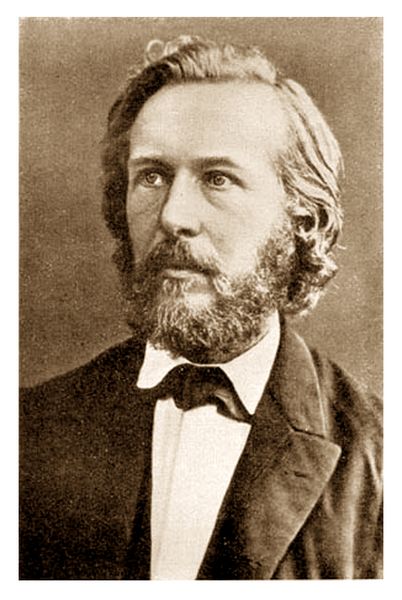Athena Review Image Archive ™
Ernst Haeckl (1834-1918)

Portrait of Ernst Haeckl at age 26 (photo: 1860)
Ernst
Haeckl (1834-1918) was a German anatomist who significantly advanced
the synthesis of traditional Linnean taxonomy with the Darwinian view
of evolution. He focused on the study of developmental or embryonic
similarities and differences between vertebrates, which frequently
yields important information, such as on the long-term evolution
of
the mammalian ear. Such analysis of key developments in fossil groups
are an important part of what is now called evolutionary
systematics.
Haeckl
added to Linnean classification the evolutionary distinction between
amniotic and non-amniotic eggs used in reproduction. This basic trait
showed that mammals and reptiles (both amniotes) share a more recent
common ancestor than do mammals and amphibians.
Amniotic eggs were first formally defined by Haeckl in 1866 on the basis of the amnion, a protective sheath around the embryo. Amniotes are vertebrates which give birth through amniotic eggs which contain the embryo in a protective, amniotic sac. Examples are a chicken egg, a turtle or crocodile egg, or a mammalian foetus. Thus the group of amniotes includes the classes of birds, reptiles, and mammals, but excludes all members of the classes of fish and amphibians. The latter (called anamniotes), have eggs which are hatched in open water and whose hatchlings, larvae, or tadpoles develop largely unprotected.
An observation by Haeckl that “ontogeny recapitulates phylogeny” has become known as "Haeckl's Law." Thus in the developmental or placental stage of a human infant (i.e., its ontogeny or coming into being), various ancestral forms emerge and then disappear (i.e., are recapitulated), including fish gills, and the reptilian jaw feature called Meckel’s Cartilage, prior to the formation of the mammalian ear, jaw, and other features fully developed prior to birth. Considered neither true nor false, but always thought-provoking, Haeckel's Law remains an important tool for studying developmental sequences in animals.
References:
Haeckl, E. 1866 Generelle Morphologie der Organismen : allgemeine Grundzüge der organischen Formen-Wissenschaft, mechanisch begründet durch die von C. Darwin reformirte Decendenz-Theorie. Berlin
Copyright © 1996-2020 Rust Family Foundation (All Rights Reserved).